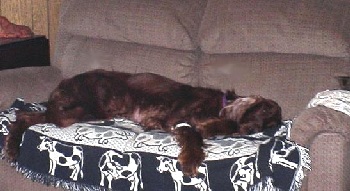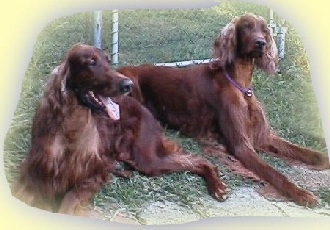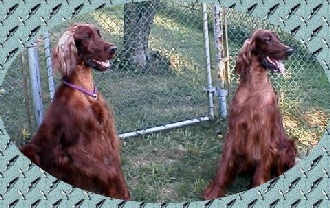 |
|
Gracie, just 3 days after the surgery that saved her life. July 15, 1999 |
|---|


Although I got my first Irish Setter, Brandy, in 1980, I'd never even heard of the term "bloat" until 4 or 5 years ago when I overheard some Irish Setter people talking at a dog show about someone's Irish having bloated and died the day before. I was shocked to learn that a medical problem that I'd never even heard of could so suddenly take the life of an Irish Setter!! I wasted no time trying to learn more about this serious medical condition that is nothing short of a life-threatening emergency!! Thank God I did because on Monday morning, July 12th, my 4-1/2 year old Irish Setter Gracie bloated.
WHAT IS "BLOAT"?
Bloat/Torsion is the common term for Gastric Dilatation-Volvulus, a term that exactly describes the course of events. (Almost every breed of dog has been affected by GDV but it's more commonly seen in large, deep-chested breeds - Akitas, Great Danes, St. Bernards, German Shepherds, Irish Wolfhounds and Irish Setters.) It's universally agreed that bloat is one of the true surgical emergencies that occurs in dogs.
Different levels of "bloat" exist. Simple bloat is where the stomach quite literally fills with air. Sometimes, however, because of the way the stomach swings in the body cavity, the ligaments stretch, and the stomach begins to rotate, closing off the openings to the stomach. At that point any air in the stomach is trapped, the pressure cuts off blood circulation, the stomach tissues begin to die and toxins begin to be released. This rotation also compresses one of the major veins carrying blood to the heart, severely depressing normal blood circulation. Rotation of the stomach also obstructs blood flow in the vein that delivers nutrients from the small intestine to the liver which produces congestion of the blood vessels, lack of oxygen supply to the tissues and eventual death of these and other abdominal organs (liver, pancreas, small intestines and spleen). ALL OF THIS CAN QUICKLY LEAD TO SHOCK AND DEATH unless immediate veterinary intervention occurs!! In Gracie's case, her stomach did a 180 degree turn. Last month, Gracie's nephew Brody's stomach also did a 180 degree turn. Five months prior to Gracie's bloat, her half-sister (and Lucy's littermate) Panda's stomach did a complete 360 degree turn. Although death is imminent without surgical intervention regardless of the degree of rotation, you have much less time to save your dog when the stomach has done a complete 360 degree rotation than you do if the rotation is 180 degrees or less (1 hour versus 4-6 hours!).
WHAT CAUSES BLOAT?
Theories abound as to why GDV occurs! One theory claims some dogs are born with their stomachs slightly out of position allowing it to twist more easily. Another theory speculates that affected dogs are born with impairment of either the esophagus or pylorus, effectively preventing food from leaving the stomach. Dogs that gulp food and then exercise heavily may also be at increased risk. Some dogs under extreme anxiety suffer "stress-related bloat" by gulping large amounts of air when nervous. In older dogs, tumors of the spleen, stomach, kidney or other internal organs may cause blockage and twisting and subsequently result in bloat. Eating indigestible materials like clothing or garbage may also cause bloating. More cases of bloat occur between the months of April and August than at any other time so one can't help but wonder if warm/hot weather can also be a contributing factor. The afternoon before Gracie bloated, she threw up a bit of grass. I'll always wonder if she ate the grass to relieve the early symptoms of her bloat or if her consumption of grass brought on the bloat. (Lucy and Gracie have both been known to do a bit of grazing from time to time and I've always attributed this to some peculiar need for a bit of roughage in their diet.) Studies have been ongoing at many veterinary schools for DECADES but, from everything I've read, the exact cause(s) of bloat remains a mystery. It would seem to me that one or a combination of contributing factors can lead to bloat. I've been saying for the last 3 years that if any dog would bloat it would be Gracie simply because she fits the "profile" that's evolved over the years -- she has a very deep chest (much deeper than Lucy's), she runs, eats and drinks like her hair's on fire, no doubt gulping a lot of air in the process (Lucy runs, eats and drinks like a lady :-), and Gracie's much more easily stressed than Lucy. (While Lucy's totally oblivious to loud noises, fireworks and thunderstorms, any of these will usually cause Gracie to seek shelter in the bathtub where she'll shake like a leaf until quiet returns.)
WHAT ARE THE SYMPTOMS?
Standard procedure now during bloat/torsion surgery is to "tack" the stomach (gastropexy) to prevent a recurrence of torsion. (The veterinarian will suture the stomach wall to a flap of peritoneum and inner abdominal muscular wall, thus permanently securing the stomach to the inner abdominal wall.) Although Gracie's stomach has been "tacked", this won't prevent a future recurrence of the bloat or "gastric dilatation" part of GDV - Dr. Manubay has strongly recommended that Gracie be given a simethicone tablet after every meal for the rest of her life.
PREVENTION
Although Gracie received medical attention in time to save her life, I know in my heart that I could have and should have reacted more quickly than I did. Gracie's always been prone to periodic stomach upsets, including restlessness and vomiting. I've been able to isolate the cause of her gastric distress to any kibble containing wheat or corn, but there's always that nagging suspicion that there may be other substances that she can't tolerate. As a result, I all but ignored her early symptoms of bloat though I do take some comfort from the fact that I did give her those 250 mg. of simethicone "just in case". If you see your dog exhibit any or all of the symptoms I listed earlier, PLEASE CALL YOUR VET AT ONCE FOR INSTRUCTIONS AND BE PREPARED TO TRANSPORT YOUR DOG IMMEDIATELY. More incidences of bloat occur between the hours of 2 a.m. and 6 a.m. than at any other time of the day. (Panda, Brody and Gracie's stomachs all rotated at around 6 a.m.!) Find out if there's an emergency animal clinic near you - one that's open during the time your regular veterinarian isn't available. If there isn't an emergency clinic near you, discuss your options with your regular vet. And, PLEASE, don't assume your regular vet can and will treat your dog if torsion has occurred!!! Ask him or her if they're familiar with GDV and ask how many times they've performed the surgery that may be needed to save your dog's life!! If you're not comfortable with the response, find a veterinarian that IS qualified to treat your dog!! Death loss due to GDV is very high. (Sadly, approximately 40-50% of the cases do not survive even with surgery.) Often owners delay in getting emergency care for their dog because they're unaware of the seriousness of the condition. Unfortunately, once the stomach has undergone volvulus (torsion), many metabolic poisons build up resulting in damage to the stomach wall, liver, spleen and heart muscle. Frequently these poisons will cause the heart to stop during surgery or they may circulate for several days post-operatively and continue to pose a threat, as will post-operative infections. With a little luck though, your dog can and will survive. If this page saves the life of just one dog, then it will have been well worth the time it took to put this page together! My last bit of advice? ... go hug your dog - that's what I'm about to do!!
 |
|
Gracie, just 3 days after the surgery that saved her life. July 15, 1999 |
|---|


Happily, 7 weeks after she bloated Gracie is back to her old self. She's put back about 6 of the 10 pounds she lost (and we're all waiting for all of the hair that was shaved off to grow back :-). As you can see from these pictures taken an hour or so ago, Gracie, who bloated with 180 degree torsion, and visiting half-sister Panda, who bloated with 360 degree torsion in February, are living proof that dogs can and do survive bloat. A big thank you to Dr. Patrick Manubay and the staff of Center West Animal Hospital, Westlake, Ohio, who saved the lives of both of these girls!!



On April 12th, 2001 my other Irish Setter, Gracie's half-sister Lucy, bloated. More lessons were learned that I'd like to share at Lucy's Bloat Page 

 Visit Lucy's and Gracie's Website
Visit Lucy's and Gracie's Website

